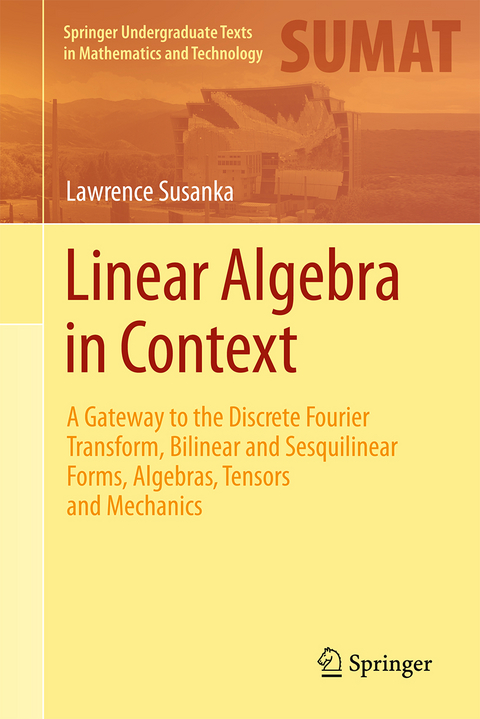
Linear Algebra in Context
Springer International Publishing (Verlag)
9783031784231 (ISBN)
This text combines a compact linear algebra course with a serious dip into various physical applications. It may be used as a primary text for a course in linear algebra or as a supplementary text for courses in applied math, scientific computation, mathematical physics, or engineering.
The text is divided into two parts.
Part 1 comprises a fairly standard presentation of linear algebra. Chapters 1-3 contain the core mathematical concepts typical for an introductory course while Chapter 4 contains numerous "short" applications. Chapter 5 is a repository of standard facts about matrix factorization and quadratic forms together with the "connective tissue" of topics needed for a coherent discussion, including the singular value decomposition, the Jordan normal form, Sylvester's law of inertia and the Witt theorems. Part I contains around 300 exercises, found throughout the text, and are an integral part of the presentation.
Part 2 features deeper applications. Each of these "large" applications require no more than linear algebra to discuss, though the style and arrangement of results would be challenging to a beginning student and more appropriate for a second or later course. Chapter 6 provides an introduction to the discrete Fourier transform, including the fast Fourier algorithm. Chapter 7 is a thorough introduction to isometries and some of the classical groups, and how these groups have come to be important in physics. Chapter 8 is a fairly detailed look at real algebras and completes a presentation of the classical Lie groups and algebras. Chapter 9 is a careful discussion of tensors on a finite-dimensional vector space, finishing with the Hodge Star operator and the Grassmann algebra. Finally, Chapter 10 gives an introduction to classical mechanics including Noether's first theorem and emphasizes how the classical Lie groups, discussed in earlier chapters, become important in this setting.
The Chapters of Part 2 are intended to give a sense of the ubiquity, of the indispensable utility, of linear algebra in modern science and mathematics and some feel for way it is actually used in disparate subject areas. Twelve appendices are included. The last seven refer to MATLAB® code which, though not required and rarely mentioned in the text, can be used to augment understanding. For example, fifty-five MATLAB functions implement every tensor operation from Chapter 9. A zipped file of all code is available for download from the author's website.
Lawrence Susanka received his PhD in Mathematics in 1991 from the University of Minnesota. He was tenured at Bellevue College for 28 years until 2019. He currently helps manage the Math and Physics Colloquium series at Bellevue. Dr. Susanka has an active interest in physics and mathematics, rock and ice climbing, chess problems, horses and running mountain trails. He is a supporter of The Planetary Society, various skeptical organizations such as the Committee for Skeptical Inquiry, and is a fan of science fiction in its myriad forms.
Preface.- Part I Linear Algebra.- 1 Basics.- 2 Vector Spaces.- 3 Bilinear and Sesquilinear Forms.- 4 Shorter Applications.- 5 Factorization.- Part II Extended Applications.- 6 The Discrete Fourier Transform.- 7 Geometry Associated with Real Bilinear Forms.- Algebras.- 9 Tensors.- 10 Mechanics: Newton, Lagrange, Hamilton, Noether.- A Permutation and the Signum Function.- B Groups.- C Polynomial Roots are Continuous in the Coefficients.- D The Fundamental Theorem of Algebra.- E There is a Basis for Every Vector Space.- F The GNU Linear Programming Kit (GLPK).- G MATLAB Code for Adjunct Matrices.- H MATLAB Code for Rotations and Euler Angles.- I. MATLAB Code for Lorentz Matrices.- J MATLAB Code to Illustrate DFT Facts.- K MATLAB Code for Quaternions, Octonions and Gamma Matrices.- L MATLAB Code for Tensor Operations.- Suggested Further Reading.- References.- Index.
| Erscheinungsdatum | 13.05.2025 |
|---|---|
| Reihe/Serie | Springer Undergraduate Texts in Mathematics and Technology |
| Zusatzinfo | XXIV, 708 p. 43 illus., 28 illus. in color. |
| Verlagsort | Cham |
| Sprache | englisch |
| Maße | 155 x 235 mm |
| Themenwelt | Mathematik / Informatik ► Mathematik ► Algebra |
| Mathematik / Informatik ► Mathematik ► Angewandte Mathematik | |
| Schlagworte | applications mechanics • bilinear forms • determinants • discrete Fourier transform • Frobenius theorem • Hurwitz theorem • Leontif input-output • linear algebra textbook • linear algebra text physical applications • Markov matrices • matrix theory • Pauli spin • quaternions • Scientific Computation • sesquilinear forms • Tensors • vector spaces |
| ISBN-13 | 9783031784231 / 9783031784231 |
| Zustand | Neuware |
| Informationen gemäß Produktsicherheitsverordnung (GPSR) | |
| Haben Sie eine Frage zum Produkt? |
aus dem Bereich


